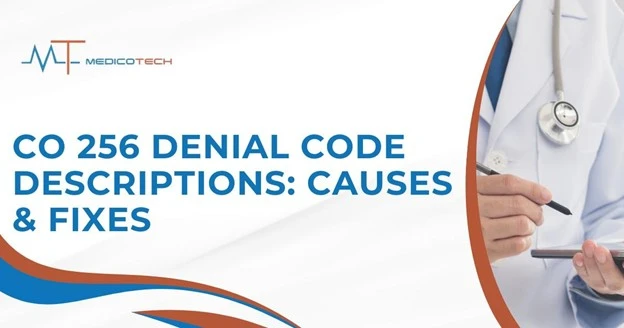The GY modifier plays a critical role in ensuring accurate and compliant medical billing practices. Used primarily to indicate services that are excluded from Medicare coverage by law, it is a vital tool for healthcare providers to prevent claim denials and ensure proper patient billing. In this guide, we will break down everything you need to know about the GY modifier, its proper application, and best practices to avoid costly errors. This guide is tailored to help you navigate the complex world of Medicare billing with full compliance.
What Is a GY Modifier?
The GY modifier is used to indicate that a service provided to a Medicare beneficiary is not covered under Medicare’s statutory exclusions. These exclusions are governed by federal law rather than medical necessity. In essence, when healthcare providers append the GY modifier to their claims, they are notifying Medicare that the service they provided is statutorily excluded, meaning it is legally not covered.
Statutory Exclusion Explained: What Medicare Never Covers
Medicare has a defined list of services that are statutorily excluded, which means these services are not eligible for reimbursement under any circumstance. Understanding these exclusions is critical because they help clarify which services Medicare will not pay for, regardless of whether the services are medically necessary. Some common statutory exclusions include:
- Cosmetic procedures: These include treatments like Botox injections, liposuction, and other aesthetic procedures.
- Routine dental care: Dental services such as cleanings, checkups, and fillings fall under this exclusion.
- Routine eye exams: Eye exams for patients without specific medical needs are not covered.
- Personal comfort items: These include luxury medical devices, such as TVs or entertainment systems in hospital rooms, which Medicare will not reimburse.
When any of these services are provided, the GY modifier must be appended to the claim, notifying the payer that the service falls under a statutory exclusion. This helps avoid confusion during the claim adjudication process and ensures providers follow Medicare billing guidelines.
GY vs. GZ Modifier: Key Differences in Non-Covered Services
It is essential to understand the difference between the GY and GZ modifiers, as both are related to non-covered services but are used in distinct situations:
- GY Modifier: This modifier is used when a service is excluded from Medicare by law (statutory exclusion). For example, services such as cosmetic surgeries or routine dental cleanings, which are specifically excluded from Medicare coverage.
- GZ Modifier: This modifier is used when a service is medically necessary but is anticipated to be denied by Medicare due to lack of coverage for a specific diagnosis or condition. The GZ modifier is typically used when the provider knows that the service will be denied, but it is still deemed necessary from a medical standpoint.
The distinction is important because using the wrong modifier could lead to billing issues and potential audit risks. The GY modifier is for statutory exclusions, while the GZ modifier addresses situations where a service is expected to be denied based on coverage, not medical necessity.
When to Use Modifier GY: 5 Legally Compliant Scenarios
The GY modifier is used in various scenarios where Medicare is not expected to cover services based on statutory exclusions. Below are the five most common and legally compliant situations for using the GY modifier:
Cosmetic Procedures (e.g., Liposuction, Botox)
Cosmetic procedures are excluded from Medicare coverage by law. Services such as liposuction, Botox, facelifts, and other purely aesthetic treatments should always be billed with the GY modifier. This indicates that Medicare does not cover these services, and the patient will be responsible for the costs.
Routine Services (Eye Exams, Dental Cleanings)
Routine services, such as eye exams and dental cleanings, fall under statutory exclusions. These services are typically not medically necessary and are not covered by Medicare unless there is a specific medical condition or diagnosis justifying the procedure. When billing for these services, the GY modifier ensures that the claim is processed correctly.
Personal Comfort Items (Entertainment Devices, Luxury DME)
Medicare excludes coverage for personal comfort items, such as entertainment devices (e.g., TVs or radios in hospital rooms) or luxury durable medical equipment (DME). These items are not considered medically necessary and should always be billed with the GY modifier.
Non-Covered Foot Care (Routine Nail Clipping, Orthopedic Shoes)
Routine foot care, such as nail clipping and the provision of orthopedic shoes, are excluded from Medicare coverage unless there is a specific medical diagnosis that justifies the treatment. The GY modifier should be appended to these types of claims to reflect that these services are not covered by Medicare.
UHC’s 2025 Policy Update: GY Requirements for Commercial Plans
In 2025, United Healthcare (UHC) has updated its policies regarding the GY modifier. This update applies to certain non-covered services under UHC’s commercial insurance plans. As with Medicare, services such as cosmetic treatments or routine eye exams will need to be billed with the GY modifier for accurate claims processing. This ensures compliance with UHC’s rules for non-covered services under their commercial plans.
GY Modifier Billing Rules:
Using the GY modifier correctly is crucial for ensuring your practice remains compliant with Medicare’s billing rules. Below are the critical guidelines for GY modifier usage in the billing process:
Proper Claim Submission: Appending GY to CPT/HCPCS Codes
When submitting claims for statutorily excluded services, it is essential to append the GY modifier to the appropriate CPT or HCPCS codes. This tells Medicare that the service provided is not covered, and the patient will be responsible for payment. Ensure that the modifier is placed correctly in the modifier field of the claim form.
Patient Financial Responsibility: Direct Billing Protocols
Since the GY modifier indicates that a service is not covered by Medicare, it shifts the financial responsibility directly to the patient. Providers must inform patients upfront about the non-coverage of these services, including obtaining consent to bill them directly for the cost. This practice ensures transparency and avoids confusion or disputes later.
ABN Not Required: When GY Replaces GA/GX
The GA and GX modifiers are typically used when providers need to notify patients about potential Medicare denial due to medical necessity issues. However, when the GY modifier is used, no Advance Beneficiary Notice (ABN) is required because the service is statutorily excluded from Medicare coverage by law. The use of the GY modifier automatically indicates that the service is non-covered, and the patient is liable for payment without the need for an ABN.
Podiatry & Chiropractic Focus: GY Modifier in Specialty Care
The GY modifier is an important tool in specialty care practices such as podiatry and chiropractic. These healthcare fields frequently encounter non-covered services that are statutorily excluded from Medicare reimbursement. Understanding the proper application of the GY modifier can help avoid billing errors and ensure compliance with Medicare’s regulations.
Non-Covered Foot Care (Routine Nail Clipping, Orthopedic Shoes)
Podiatry services, particularly routine foot care, often require the use of the GY modifier. Routine nail clipping or the provision of orthopedic shoes are common services that are excluded from Medicare coverage under statutory exclusions. These services are typically provided for convenience or comfort rather than to treat a specific medical condition.
Medicare does not cover routine foot care unless the patient has a documented medical condition that justifies the service. For example, diabetic foot care or treatment for vascular disease may be covered, but services like nail clipping or fitting shoes solely for comfort are statutorily excluded. In these cases, the GY modifier should be appended to the claim to indicate that the service falls under the statutory exclusion and is not covered by Medicare.
For chiropractic services, the GY modifier is used when services like spinal manipulation or other non-covered treatments are provided. Understanding when and where to use the GY modifier in these specialized fields ensures that your claims are processed correctly and helps avoid unnecessary denials.
UHC’s 2025 Policy Update: GY Requirements for Commercial Plans
In 2025, United Healthcare (UHC) introduced policy changes that specifically affect how the GY modifier is applied to commercial plans. These changes are designed to streamline the claims process and ensure that services that fall under statutory exclusions are handled correctly.
UHC now requires providers to use the GY modifier for specific non-covered services provided to patients under their commercial insurance plans. This policy update impacts various types of treatments, including cosmetic procedures, routine screenings, and comfort items. Healthcare providers must be aware of these new requirements to avoid misapplying the modifier and facing potential claim denials.
As with Medicare, when a service is statutorily excluded from coverage, the GY modifier signals to UHC that the service is not eligible for reimbursement. Properly adhering to UHC’s updated guidelines will help avoid issues with billing and reimbursements.
GY Modifier Mistakes That Trigger Audits or Denials
Understanding how to properly apply the GY modifier is essential in avoiding billing mistakes that could lead to audits, denials, or even fraud charges. Common errors can lead to significant delays in reimbursement, and in some cases, providers could face penalties for submitting claims incorrectly.
Incorrect Use Case: Statutorily Excluded vs. Medically Unnecessary
One of the most common mistakes made by healthcare providers is misusing the GY modifier in cases where the service is medically unnecessary, rather than statutorily excluded. It’s important to differentiate between services that are excluded by law and those that are deemed medically unnecessary but could still be covered under other circumstances.
For instance, a service that is medically unnecessary but is covered under certain conditions (like a diagnostic test for a covered medical condition) should not be billed with the GY modifier. Instead, a modifier like the GZ modifier might be more appropriate to indicate that the service is medically unnecessary but is still likely to be denied by Medicare.
Misapplying the GY modifier in these cases could trigger audits or denials, as the insurance provider might interpret the use of the modifier as fraudulent or improper, especially in complex fields like orthopedic medical billing. Providers should be aware of common denial codes, such as CO 29 denial code, which can result from incorrect modifier usage.
Bundled Services and Add-On Codes: Where GY Doesn’t Apply
Another mistake to avoid is applying the GY modifier to bundled services or add-on codes. In some cases, services may be part of a bundled payment or package, meaning that they are grouped together and billed as a single unit. The GY modifier should not be used in these situations, as it applies only to services that are statutorily excluded from coverage, not to those bundled or grouped under a specific code.
When submitting claims for bundled services, be sure to follow the correct billing procedures and apply the appropriate modifiers for services within the bundle. Using the GY modifier inappropriately could result in denials or further review of your claims.
Future-Proofing Your Practice: 2025 Policy Changes
With regulatory changes on the horizon, it’s important for healthcare providers to stay ahead of Medicare policy updates and private insurer requirements. The GY modifier is subject to evolving policies, and understanding upcoming changes will ensure your practice remains compliant.
UHC’s GA + GY Hybrid Rules for Medicare Advantage
In 2025, United Healthcare (UHC) will implement a GA + GY hybrid rule for Medicare Advantage plans. This rule combines both the GA modifier (used to indicate that an Advance Beneficiary Notice of Non-Coverage (ABN) has been signed) and the GY modifier (used to signal that a service is statutorily excluded from coverage). This hybrid approach is designed to streamline billing for services that are non-covered and ensure that patients are clearly informed about their financial responsibilities.
Providers will need to stay updated on these rules to properly apply the hybrid modifiers when submitting claims for Medicare Advantage members. Failing to apply the correct modifier combination could lead to incorrect billing and a higher risk of claims being denied or delayed.
State-Specific Medicaid Variations
Medicaid policies can vary significantly from state to state, and state-specific Medicaid variations can affect the application of the GY modifier. Some states may have more lenient rules regarding non-covered services, while others may adhere strictly to federal exclusions. As a result, providers should ensure they are familiar with the Medicaid rules in each state where they practice.
For example, while Medicare may exclude certain services like routine dental care, some state Medicaid programs might offer coverage for specific dental services or other procedures that are typically excluded. The GY modifier may not always be appropriate for state Medicaid claims, and using it incorrectly could trigger denials or compliance violations.
Does a GY Modifier Require an Advance Beneficiary Notice (ABN)?
One frequently asked question is whether the GY modifier requires an Advance Beneficiary Notice (ABN). The short answer is no. Unlike other modifiers such as the GA or GX, which are used when a provider anticipates a Medicare denial and requires the patient’s consent to pay, the GY modifier automatically shifts the financial responsibility to the patient without needing an ABN.
Why GY Automatically Shifts Liability to Patients Without an ABN
The GY modifier is used specifically for services that are statutorily excluded from Medicare coverage. These services are not subject to the same rules as medically unnecessary services, so the patient is directly responsible for the costs. Since the service is not covered by Medicare in any case, an ABN is not required. The GY modifier inherently communicates that the service is excluded, thereby transferring the financial responsibility to the patient.
Can You Bill a Patient Directly With Modifier GY?
Yes, once the GY modifier is applied to a claim, the financial responsibility for the service shifts to the patient. However, it’s essential to follow a clear process when billing patients directly for these non-covered services.
Step-by-Step Process for Patient Collections After GY Denial
- Notify the Patient in Advance: Inform the patient upfront that the service is statutorily excluded and that they will be responsible for the payment.
- Submit the Claim: Use the GY modifier on the appropriate CPT or HCPCS codes and submit the claim to Medicare or the insurer.
- Follow-Up on Denial: Once the claim is denied, send the patient an itemized bill outlining the denied services and their responsibility for payment.
- Offer Payment Options: Provide patients with payment plans or other options to help manage the cost of the non-covered service.
What Happens If You Misuse the GY Modifier?
Misusing the GY modifier can have serious consequences, including audit risks, false claims penalties, and reimbursement reversals. Providers who incorrectly apply the modifier, such as using it for medically unnecessary services, may face scrutiny from Medicare auditors or private insurers. Penalties for improper use can include financial fines, loss of reimbursement, and reputational damage.
What is the GY modifier used for?
The GY modifier is used in medical billing to indicate that a service is statutorily excluded from Medicare coverage. It helps to clarify that the service provided is not eligible for reimbursement under Medicare’s rules.
When should I use the GY modifier?
The GY modifier should be used when billing for services that are excluded by law from Medicare coverage, such as cosmetic procedures, routine dental care, and personal comfort items like luxury durable medical equipment.
Do I need an Advance Beneficiary Notice (ABN) when using the GY modifier?
No, an ABN is not required when using the GY modifier. Since the service is statutorily excluded from Medicare coverage, the financial responsibility shifts directly to the patient without the need for an ABN.
What happens if I misuse the GY modifier?
Misusing the GY modifier can lead to claim denials, audits, and potential penalties. It’s crucial to use it only for services that are legally excluded from Medicare coverage, not for medically unnecessary services.
Can I bill a patient directly using the GY modifier?
Yes, when the GY modifier is applied, the patient is responsible for the cost of the service. Providers can bill the patient directly, but it’s important to inform the patient about their financial responsibility




